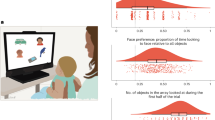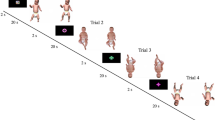A neonatal right-side preference makes a surprising romantic reappearance later in life.
Abstract
A preference in humans for turning the head to the right, rather than to the left, during the final weeks of gestation and for the first six months after birth1,2 constitutes one of the earliest examples of behavioural asymmetry and is thought to influence the subsequent development of perceptual and motor preferences by increasing visual orientation to the right side3,4. Here I show that twice as many adults turn their heads to the right as to the left when kissing, indicating that this head-motor bias persists into adulthood. My finding may be linked to other forms of sidedness (for example, favouring the right foot, ear or eye) that do not become established until long after the newborn head-turning preference has disappeared5,6.
Similar content being viewed by others
Main
I observed kissing couples in public places (international airports, large railway stations, beaches and parks) in the United States, Germany and Turkey. The head-turning behaviour of each couple was recorded for a single kiss, with only the first being counted in instances of multiple kissing. The following criteria had to be met to qualify: lip contact, face-to-face positioning, no hand-held objects (as these might induce a side preference), and an obvious head-turning direction during kissing. Subjects' ages ranged from about 13–70 years.
Of 124 kissing pairs, 80 (64.5%) turned their heads to the right and 44 (35.5%) turned to the left (Fig. 1). This roughly 2:1 ratio is significantly different from 50% (χ2 = 5.34, d.f. = 1, P < 0.05). As the couples come from a biologically adult age range, this result indicates that adults have a head-turning bias towards the right side, just like embryos and newborns.
Preferential use of the right foot, ear or eye is also evident as a 2:1 ratio7, which raises the possibility that these biases may be decreed by the observed head-turning preference. The incidence of right-handedness, however, is about 8:1 (ref. 8), so this particular asymmetry cannot be the result of a simple bias attributable to a right-sided head-turning tendency — the genetic origins of this trait may be different8, or cultural factors may have modified an original 2:1 pattern.
It takes two people to kiss (Fig. 2), so the bias of individuals cannot be judged from observations made on pairs. For example, what happens when a right-turner kisses a left-turner? If we assume that kissers with opposite biases could go either way with equal probability, then the individual biases should match those of the couples. For example, if the individual bias is also 2:1 to the right and if couplings are random, then four of nine pairs would be right kissers, one of nine would be left-kissing, and four of nine would be mixed; if choice is random in the last group (that is, two of these four pairs are right-turning and two are left-turning), the result for the nine couples would be a right-turn kissing bias in six of them. This presumed 2:1 distribution for individuals thus predicts the observed 2:1 ratio for couples, indicating that the group bias may also reflect individual asymmetry.
In birds, a preference for turning the head to the right before hatching induces motor9, visual10 and cognitive11 asymmetries. If a similar effect occurs in humans and an initial asymmetry in the direction of head turning stimulates various functional left–right differences12, then the head-turning bias of the newborn would have to overlap in time with the establishment of adult asymmetries. My finding that turning of the head to the right is preferred throughout adulthood suggests that, by fostering a constant bias towards the right, this mechanism may be able to induce or enhance right-sided asymmetries of perception and action.
References
Ververs, I. A. P., de Vries, J. I. P., van Geijn, H. P. & Hopkins, B. Early Hum. Dev. 39, 83–91 (1994).
Konishi, Y., Mikawa, H. & Suzuki, J. Dev. Med. Child Neurol. 28, 450–457 (1986).
Konishi, Y., Kuriyama, M., Mikawa, H. & Suzuki, J. Dev. Med. Child Neurol. 29, 751–757 (1987).
Coryell, J. F. & Michel, G. F. Infant Behav. Dev. 1, 245–257 (1978).
Michel, G. F., Sheu, C.-F. & Brumley, M. R. Dev. Psychobiol. 40, 1–13 (2002).
Gentry, V. & Gabbard, C. J. Gen. Psychol. 122, 37–45 (1995).
Reiss, M. & Reiss, G. Percept. Mot. Skills 85, 569–574 (1997).
Corballis, M. C. Psychol. Rev. 104, 714–727 (1997).
Casey, M. B. & Martino, C. M. Dev. Psychobiol. 37, 13–24 (2000).
Skiba, M., Diekamp, B. & Güntürkün, O. Behav. Brain Res. 134, 149–156 (2002).
Rogers, L. J. & Andrews, R. J. (eds) Comparative Vertebrate Lateralization (Cambridge Univ. Press, Cambridge, UK, 2002).
Nicholls, M. E., Clode, D., Wood, S. J. & Wood, A. G. Proc. R. Soc. Lond. B 266, 1517–1522 (1999).
Author information
Authors and Affiliations
Corresponding author
Ethics declarations
Competing interests
The author declares no competing financial interests.
Rights and permissions
About this article
Cite this article
Güntürkün, O. Adult persistence of head-turning asymmetry. Nature 421, 711 (2003). https://doi.org/10.1038/421711a
Issue Date:
DOI: https://doi.org/10.1038/421711a
This article is cited by
-
Embracing your emotions: affective state impacts lateralisation of human embraces
Psychological Research (2019)
-
Kissing Right? Absence of Rightward Directional Turning Bias During First Kiss Encounters Among Strangers
Journal of Nonverbal Behavior (2019)
-
Arm swing asymmetry in overground walking
Scientific Reports (2018)
-
The right way to kiss: directionality bias in head-turning during kissing
Scientific Reports (2017)
-
Internet gaming disorder, social network disorder and laterality: handedness relates to pathological use of social networks
Journal of Neural Transmission (2015)
Comments
By submitting a comment you agree to abide by our Terms and Community Guidelines. If you find something abusive or that does not comply with our terms or guidelines please flag it as inappropriate.





